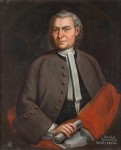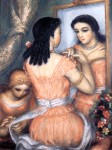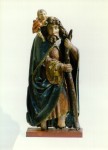The History and Art Collection, Art Section
Collection items include paintings, prints, drawings, sculptures, and historical photographs. Central European paintings and sculptures of outstanding artistic value, as well as works by regional artists are represented.
The oldest painting is a Renaissance Madonna on wood from the first half of the 16th century by Flemish painter Lambert Lombard, who was an important figure in the development of the Antwerp School. Among his disciples was Frans Floris, who became a very famous Flemish painter. The museum houses a large collection of paintings from the Baroque period.
Towards the end of the 17th century, the paintings ‘Diana, the Queen of Nature’ and ‘In Vulcan’s Workshop’ were painted in Italy. The 18th century is represented by biblical themes, portraits, and landscapes. Portraits of Leopold I, Joseph I, Charles VI, and Maria Theresa depict the important Habsburg family. Among the bishops of Olomouc are paintings depicting Protasius von Boskowitz und Černahora, Hannibal Wolfgang Schrattenbach, Jakob Ernst von Liechtenstein-Kastelkorn, Ferdinand Julius von Troyer, and Maximilian Hamilton. Inside the museum, you can see a painting of the Teaching of the Virgin Mary, painted by František Vavřinec Korompay.
Among other pieces, the painting of the ‘Adoration of the Virgin Mary’ by František Antonín Sebastini-Šebesta is noteworthy. One of the most important works of late Baroque painting is St. Florian by the Austrian painter Franz Anton Maulbertsch.
Portrait paintings in the 19th century were mainly commissioned. The painting of writer Johanna Bischoff, née Kuh, (1798–1891), is from the first half of the 19th century. The portrait, representing the later writer and wife of prominent physician Ignaz Rudolf Bischoff von Altenstern as a girl, is an example of a quality Viennese painting. The painting ‘Mountain Brook in the Salzkammergut near Berchtesgaden’ was painted in the 1870s by Albert Rieger, an Austrian landscape painter and lithographer. Vojta Hlaváček’s painting ‘Vyškov Square’ documents Vyškov Square before the remodelling of the savings bank (1874) and the repairs made to the parish tower. The painting depicts the historical buildings on the square with arcades and attic gables. The painting is a rather rare historical document because Vyškov was affected by a large fire in 1917 that changed the character of its historical centre. The appearance of Vyškov Square before this event is known only from historical photographs, postcards, and surviving paintings. The 19th century is mainly represented by portrait paintings and paintings with religious themes. The museum also has a large collection of paintings from the 20th century. These are usually works by painters of the Vyškov Region and paintings thematically connected to the Vyškov Region.
Among the artists of the Vyškov Region, the most important painter is Antonín Procházka, whose works are also represented in the museum’s collections. Two theatre curtains by Antonín Procházka are on display in the museum. The curtain ‘Family Happiness’ is from Važany and contains silhouettes of dancing girls painted on the other side of the canvas. The second curtain from Moravské Prusy is entitled ‘Vesna’. The museum’s collections also include paintings by František Srp, Helena Bochořáková-Dittrichová, Svatopluk Souček, Ferdinand Kotvald, Josef Zamazal, Marie Št’astná, Josef Urbánek, Petr Pištělka, Josef Kachlík, Jiří Homola, and Jan Hauber. There are 4 late Gothic sculptures in the collection, the most important of which is a polychrome woodcarving of the Madonna from around 1520. From a later period, there is an interesting Renaissance woodcarving of St. Wenceslas and a Rococo polychrome woodcarving of St. Rosalia. The 20th century is represented by sculptures by Bučovice carver Josef Staňek. The most comprehensive set of drawings is the documentary cycle by Josef Kachlík.
He focused on Vyškov and other towns and villages in the region. He documented squares, streets, landmarks, and minor rural structures. A larger number of drawings were made by Svatopluk Souček. He depicted different themes but his set of drawings depicting various crafts and craftsmen at work is interesting. Petr Pištělka focused on depicting various themes from village life, folk costumes, and structures. His prints feature varied subjects, authors, and techniques. Many of the graphic sheets are dedicated to different locations. A large set of graphic sheets is by Helena Bochořáková-Dittrichová.





